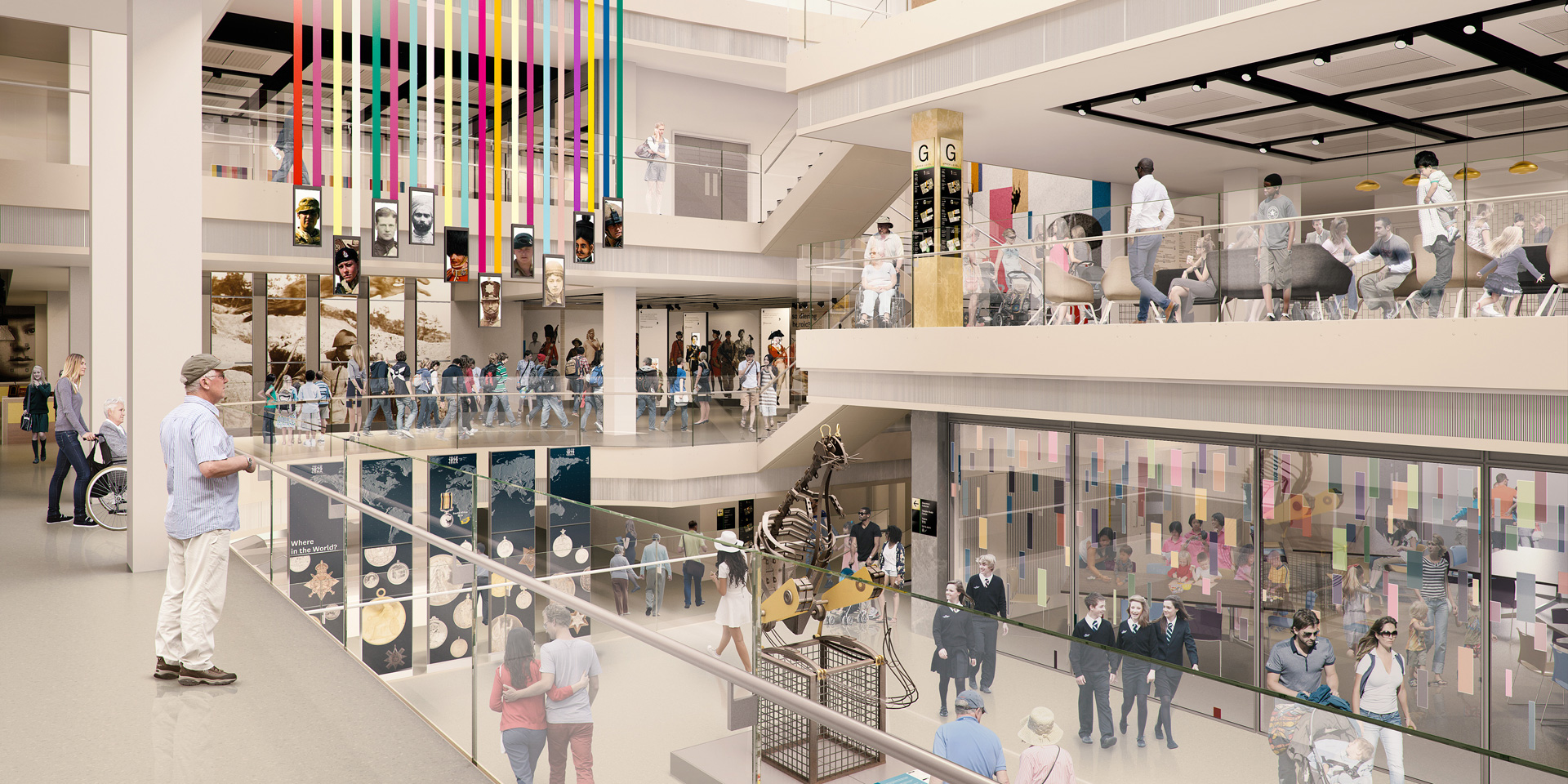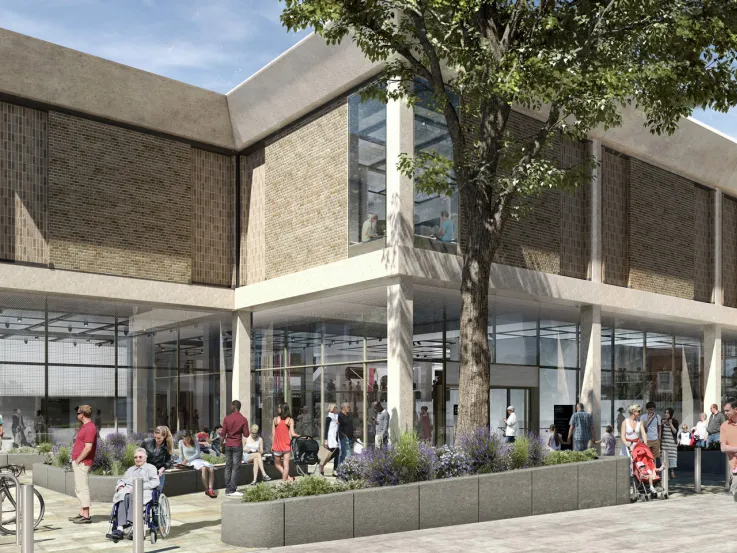National Army Museum marches towards opening
Today, the National Army Museum has announced that it will open to the public on 30 March 2017 after a three-year £23.75 million re-development project including £11.5 million from the Heritage Lottery Fund (HLF).
The Museum has gone through a radical transformation to maximise access to, and engagement with, the Collection. The main Chelsea site has been reconfigured with architects BDP and design agency Event to create a more welcoming, accessible and flexible environment, enabling the National Army Museum to manage increasing visitor figures, predicted to reach 400,000 by 2026. Aiming to be a bridge between the British Army and society the Museum will encourage greater public engagement with ideas of defence and security, both past and present.
The bright new building will include over 2,500 objects in five permanent thematic galleries, laid out over four floors – Soldier, Army, Battle, Society and Insight. There will also be a 500 square meter temporary exhibition space, a study centre, a three-room learning centre, as well as a brand new café, shop and Play Base, where children aged zero to seven can learn through play.
The first gallery that visitors will enter is Soldier. This gallery draws on the abundance of individual stories contained within the National Army Museum’s collections and archive. It brings to life displays of personal, and often inspiring, objects that explore the physical and emotional experience of soldiering throughout the army’s history. While the army may be almost 400 years old, the thoughts, feelings and human experience of soldiers remain remarkably similar.
The gallery will follow the life of a soldier from joining the army to training and daily life, and the reality of crime and punishment, to exploring both combat and non-combat roles and finally coming home. Visitors can engage with a series of tests to find out if they could become a soldier and can be drilled in marching. Objects on display within the gallery include Crimean Tom, a cat found during the Crimean War and brought back to Britain as a pet; the Welsh flag which formed part of the memorial of a soldier who was wounded in Afghanistan in 2009 and later died in hospital; and James McGuire’s Victoria Cross, which he received for gallantry during the Indian Mutiny but lost when he was convicted of stealing his uncle’s cow!
The Army gallery charts the history of the army as an institution. It explores its origins in the chaos of the British Civil Wars, (such as the Flag of Gells Regiment) its major role in the political development of the country onto its impact on global history. Finally the gallery looks at how the British Army tries to remain relevant through technological and social change including the change in modern recruitment posters.
Visitors will be able to explore how the army has adapted and evolved in the face of political and popular policy, changing circumstance and innovation to remain effective and achieve its objectives. The international story of the British Army will be told through paintings including portraits of Oliver Cromwell and Khudadad Khan VC (the first Indian Solder to win the Victoria Cross) as well as the first official representation of black soldiers in the army on the Regimental Colour of the West India Regiment.
The Battle gallery explores the British experience of battle from the 1640s to the present day. Throughout this period tactics evolved in the light of technological development and became a major determinant of victory in battle. However, when tactics did not keep up with the technological development such as the machine gun, the scale of casualties became horrific.
Visitors will be able to experience some of these technological developments through interactives such as driving a tank or drumming a battle command. The Battle of Waterloo will be brought to life with a new multimedia interpretation of the Siborne Model that enables visitors to investigate both the model and the famous battle.
The largest number of new acquisitions feature in the Society gallery where objects and stories are brought together to examine the army as a cultural as well as a military force. The gallery looks at the army’s impact on our customs, values and choices, from the toys (Action Man) and music (Jimi Hendrix by Gered Mankowitz) we create to the way we vote, underpinned by the real experiences of both civilians and soldiers.
Looking at the army in fashion (Burberry Trench Coat), fiction (War Horse) and journalism (Kate Adie’s Flak Jacket, helmet, identity discs and press pass), and at its impact on medicine, technology and benevolence, the army is revealed as recognisable and distant, loved and loathed. The gallery also examines moments when communities have encountered British soldiers in circumstances of conflict, natural disaster and national security.
The Insight gallery examines the impact the British Army has had around the world. No other army has seen service in so many different countries or interacted with such a huge range of peoples and cultures.
Intended as a regularly changing exhibition, the gallery’s opening displays look at the army’s connection with Germany, Scotland, the Punjab, Ghana and Sudan. Communities from these areas have been involved in the creation of the gallery, sharing thoughts on their relationship with Britain, the army and the objects within the Museum’s collection, such as a Nazi Car Pennant and a cup from the 1745 Jacobite Rebellion.
Janice Murray, Director General said:
‘The new National Army Museum is a bright, contemporary space where visitors of all ages can learn about the British Army past and present. The thematic galleries provide a space to explore and discuss the army and its relevance to society in ways that we sometimes would not imagine from fashion and films to flood defences and, of course, conflict. We are excited to welcome visitors to come and explore this story with us in the new Chelsea museum.’
Sir Peter Luff, Chair of HLF said:
‘The National Army Museum is quite literally transformed. It’s always been a great place to learn about the British Army’s role in military and civilian life but it now has an inspiring new energy and purpose. The clean, spacious design should please regular visitors and also attract a whole new audience. We're sure this will include many National Lottery players who have made such a big contribution to the site’s redevelopment.’
Notes for editors
For more information, please contact the National Army Museum press office at pr@nam.ac.uk or 020 7881 2433.
National Army Museum
The National Army Museum is the leading authority on the history of the British Army. Founded in 1960 by Royal Charter and established for the purpose of collecting, preserving and exhibiting objects and records relating to the Land Forces of the British Crown it is a museum that moves, inspires, challenges, educates and entertains. The Museum tells the story of the British Army, the personal experiences of the soldiers who have served and connects the British public and its Army demonstrating how the role of the Army and its actions are still relevant today.
Heritage Lottery Fund
Using money raised through the National Lottery, the Heritage Lottery Fund (HLF) aims to make a lasting difference for heritage, people and communities across the UK and help build a resilient heritage economy. HLF has supported 36,000 projects with £6bn across the UK.
For more information, please contact Katie Owen, HLF press office, on tel: (020) 7591 6036 out of hours mobile: 07973 613820.






